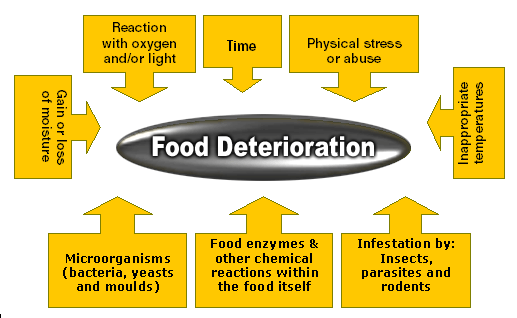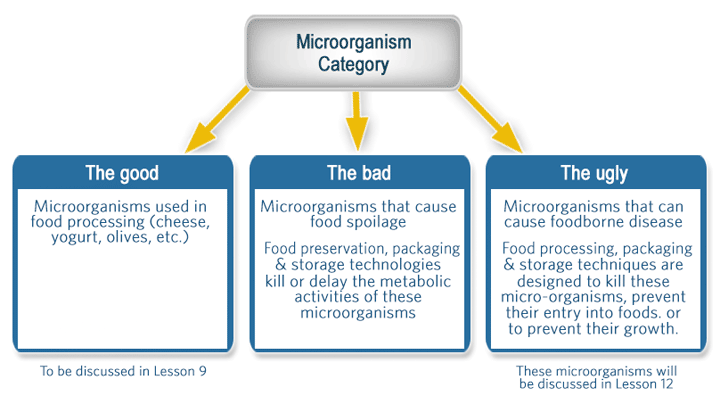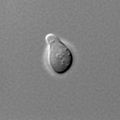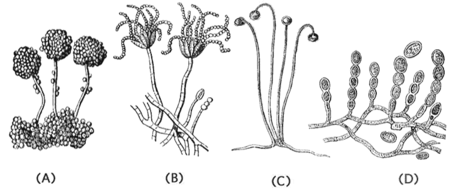Course:FNH200/Lessons/Lesson 05
5.0 Overview
In this lesson you will learn about the chemical, enzymatic and microbiological factors that are responsible for food deterioration and spoilage. We will discuss the important environmental factors in food that affect the growth of disease-causing and spoilage-causing microorganisms in food. You will also learn about various types of chemical spoilage, such as enzymatic browning of fruit and vegetable tissues. Finally, as an introduction to food preservation, you will learn the principles upon which food preservation techniques are based. Upon completing this lesson you will have the fundamental knowledge required to fully appreciate the concepts of food preservation to be covered in Lessons 6 through 10.
Objectives
After completing this lesson, you will be able to:
- describe the factors (chemical, enzymatic, microbiological) that commonly contribute to food deterioration and spoilage;
- summarize possible mechanisms for inhibiting the factors that promote deterioration of quality in food systems
5.1 Food Deterioration: the need for food preservation
Terms to remember |
|
- About 10-20 % of all agricultural commodities are lost each year (pre-harvest deterioration) due to: weeds, insects, microorganisms, rodents and birds.
- All foods (agricultural & aquatic products) undergo varying degrees of deterioration after harvest (post-harvest) and during storage.
- Losses occur in the nutritional value, safety, and aesthetic appeal (colour, texture, flavour).
- Food is subject to physical, chemical and biological deterioration.
- Food deterioration involves: heat, cold, light, oxygen, moisture, dryness, food enzymes, microorganisms and macroorganisms (see figure below).
The objective of food preservation technologies is to delay the onset of spoilage and to enable the creation of new food products from the resource commodities. The different factors that can lead to deterioration of food are shown in Figure 5.1 and are described in more detail in the next sections.

5.2 Microorganisms
- Microorganisms are ubiquitous. Almost all food materials that arrive at food processing plants, retail stores, food service receiving docks, and even your kitchen, are contaminated with a variety of microorganisms.
- Microorganisms cause a great deal of food spoilage throughout the world. This has major economic consequences and also result in loss of potential sources of nutrients, since the spoiled food typically is discarded.
| Want to learn more? |
|
Microorganisms can be classified into 3 general categories as shown in Figure 5.2.

From Fig 5.2., we note that microorganisms can be put to good use for the production of fermented foods, but that they can also be the causes of spoilage and food borne diseases. Bacteria, yeasts and moulds may contribute to production of fermented foods, as well as food spoilage and food borne disease. Viruses although not considered true microorganism they can be agents of food borne disease but do not cause food spoilage, nor are they used to produce fermented foods.
In this lesson, we will focus primarily on obtaining a general understanding of the role of microorganisms in the deterioration or spoilage of food. The importance of microorganisms in fermented foods and food borne diseases will be discussed in more depth in Lessons 9 and 12, respectively.
Some important characteristics of microorganisms in foods causing food spoilage are summarized below:
Bacteria

Bacteria are the microorganisms that grow the fastest in food.
They reproduce by cell division, whereby one cell divides into two, and these two daughter cells further each divide into another two cells.
The time taken for bacterial cells to complete one complete cycle of cell division is the generation time. With a generation time of 7 minutes, a single bacterial cell could produce a population of a billion cells within 210 minutes (3 1/2 hours).
Bacteria may exist in two forms:
vegetative cells, which are actively metabolizing cells, consume nutrients and produce waste products.
spores, which are the dormant form of the bacterial cell. The spore is analogous to the seed of a green plant. All of the genetic material is contained within the spore. When favourable conditions are encountered, the spore germinates and produces an actively metabolizing bacterial cell capable of cell division).
Yeasts

Yeasts are commonly found in many foods of agricultural and aquatic origin. Yeasts reproduce by budding.
They generally grow more slowly than bacteria but can tolerate more severe environmental conditions than bacteria.
- For example yeasts are not inhibited by pH to the same extent as bacteria
- Yeasts can grow in many foods with low water activity that would normally inhibit growth of bacteria
Some yeasts are used to produce fermented foods and beverages.
Moulds


Moulds are filamentous and are also found on most foods of agricultural and aquatic origin. Most moulds produce spores.
Like yeasts, moulds can grow on foods that have a low pH and also in foods with low water activities that would inhibit growth of bacteria and yeasts.
Some moulds are used in the production of mould-fermented foods (e.g. mould ripened cheeses), but most moulds are agents of food spoilage and many also produce toxins (mycotoxins) under favourable conditions.
What are microbial spores?
- Mold and some bacteria produce spores. Microbial spores are very resistant to a variety of conditions (heat, dehydration, ionizing radiation, antimicrobial agents) that can inhibit or cause death of the vegetative cell.
- In food preservation and processing, the spores of Clostridium botulinum, an anaerobic bacterium, are of great concern because the spores are very heat resistant. Clostridium botulinum is also the group of bacteria that produces the toxin that causes the very serious illness, botulism. We will discuss Clostridium botulinum in more detail in Lessons 6 and 12
Oxygen and temperature requirements for microorganisms:
Microorganisms can also be characterized on the basis of temperature ranges and oxygen requirements over which growth occurs. For example, mould are strictly aerobic (require oxygen), but different mould species can have different temperature requirements. Some bacteria are aerobic mesophiles, and some are anaerobic mesophiles.
Oxygen requirements:
- AEROBIC: grow only in the presence of dissolved oxygen (Bacteria, yeast, mould)
- ANAEROBIC: grow only in the absence of dissolved oxygen (Bacteria)
- FACULTATIVE ANAEROBE: can grow in the presence or absence of oxygen (Bacteria, yeast)
| Temperature requirements | ||
|---|---|---|
| Classification | Growth temperatures (°C) | Characteristics |
| Psychrophiles
Psychrotrophs |
0 to 18
-5 to 35 |
Psychrophiles grow well in cold temperatures, while Psychrotrophs have adapted to living and multiplying in cold environments. Psychrotrophs are the major cause of spoilage in refrigerated foods. |
| Mesophiles | 10 to 45 | Mesophiles grow well in moderate temperatures. Many mesophiles have an optimum growth temperature of 37°C. Most spoilage and disease-causing organisms are mesophiles. |
| Thermophiles | 50 to >100 | Thermophiles grow best at high temperatures. Most thermophilic organisms are spoilage-causing. |
5.3 Insects, Rodents and Parasites
- Pests are major contributors to post-harvest losses
- Rodents alone ruin >30,000,000 tonnes of food each year worldwide
- Insects are believed to destroy 5-10% of the U.S. grain crop annually, and in some parts of the world this figure can be as high as 50%
- Pests will damage the food and open it to microbial contamination
- Rodent, insect and bird control are important factors in the agriculture and food industries.
You may have had first-hand experience with insects or rodents causing food deterioration in your home. These organisms are often referred to as food pests and the food industry pays a great deal of attention to pest management. If you have had problems with food pests in your pantry or cupboards, you will appreciate the damage they can cause and the fact that great efforts must be taken to control their activities and invasiveness.
Parasites can cause damage to food quality. An example is the visible appearance of parasitic cysts in fish flesh which lowers the quality and market value of infested products. Parasites such as Trichinella spiralis in pork and Anisakis species in some types of fish can also cause health problems in humans if they are ingested through inadequately cooked or improperly processed foods, infested with those parasites.
5.4 Enzymes Endogenous to Foods
Enzymes can catalyze reactions leading to chemical changes in foods. Living organisms (animal and plant) have their own enzyme balance. This enzyme balance is disrupted once the animal is killed or the plant is harvested, but the enzymes may continue to catalyze chemical reactions within foods even after slaughter or harvest.
Some examples of enzymatic deterioration in foods are described below:
- The softening of fruit tissue and the changes in flavour and colour during storage after picking are examples of deterioration of food quality by enzymes. It is enzymatic action that causes the softening of apple tissue during storage, with texture changing from that of a crisp apple to a somewhat soft and mealy apple with a concomitant loss of sweetness. Enzymes in the apple tissue degrade pectins that cement the cells together, leading to the textural change.
- You also no doubt have experienced the browning of apples, potatoes and peaches after they have been sliced and exposed to oxygen in the atmosphere. This browning phenomenon is known as enzymatic browning and is catalyzed by an enzyme known as polyphenol oxidase which catalyzes the oxidation of colorless phenols in the tissues to brown colored compounds, as shown in the following equation:
Enzymes can catalyze reactions leading to chemical changes in foods. Living organisms (animal and plant) have their own enzyme balance. This enzyme balance is disrupted once the animal is killed or the plant is harvested, but the enzymes may continue to catalyze chemical reactions within foods even after slaughter or harvest.

Enzymes can be inactivated by means of heat, chemicals (e.g. antioxidants), and by controlling the gaseous environment.
5.5 Factors Affecting Microbial Growth, Enzyme Activity and Chemical Reactions in Foods
Temperature, moisture and oxygen as well as light may have profound influences on microbial growth, enzyme activity and chemical reactions in foods.
Temperature effects:
- Rates of reactions generally increase as the temperature increases until an optimum is achieved, after which further increases in temperature cause the rates of reaction to decrease because of inactivation of microorganisms or enzymes or because of inhibitory effects on chemical reactions.
- Excessive heat also denatures proteins, breaks emulsions, removes moisture from foods (drying out), and destroys vitamins.
- Cold temperatures can also deteriorate food. A well known example is "chill injury", the change in texture and discolouration of fruits and vegetables when they are exposed to freezing temperatures.
- Freezing temperatures can deteriorate liquid foods such as milk, causing emulsions to break and fat to separate, and denaturing protein causing it to curdle or coagulate. "Freezer burn" due to loss of moisture can occur in solid and liquid foods.
Gain or Loss of Moisture:
- Water loss during storage (e.g. wilting of lettuce in the refrigerator), or water uptake (e.g. by dehydrated foods) can lead to deterioration.
- Retrogradation of starch, resulting in staling of bread, is caused by packing of linear starch molecules leading to the exclusion of water that was previously absorbed during gelatinization. The bread becomes tough and develops a dry texture.
- Changes in water activity (free versus bound water) can influence chemical and enzymatic reactions and microbial growth.
Oxygen effects:
- Oxygen is an important factor in food quality, since many oxidative reactions lead to deterioration in the quality of food and, in some cases, to losses in nutritive value. Oxidative deterioration is often accelerated by light.
- For example, deterioration frequently occurs because of oxidation of the fats in food products. The development of rancidity in breakfast cereals, vegetable oils and oil-based products, and in deep-fried foods is due to reaction of oxygen with fats, particularly those with high unsaturated fatty acid content. This type of rancidity is known as oxidative rancidity. This is in contrast to rancidity induced in foods upon the release of free fatty acids by very high temperatures or by the action of lipase enzymes, either endogenous or produced by spoilage-causing microorganisms. The latter rancidity is known as hydrolytic or lipolytic rancidity.
- Oxidation of vitamins and colour pigments can lead to the deterioration of nutritive quality and aesthetic appeal of foods.
Physical deterioration:
- Physical abuse causes tissue disruption and release of enzymes into tissues which can lead to changes such as enzymatic browning mentioned earlier.
- Furthermore, improper packaging, for example, can cause crushing and tissue damage, making foods such as fruits and vegetables particularly susceptible to microbial invasion as well as enzymatic and chemical reactions.
Time:
- For the majority of foods, quality will decrease with time.
- Food preservation, packaging and storage practices are aimed to maintain this quality for as long as possible (shelf life); however, eventually the quality of any food will decrease with time.
5.6 Principles of Food Preservation
Food commodities are classified based on their shelf-life expectancy. Depending on the type of food and the type of preservation (processing) method used, their shelf-life can vary from a few days to several months or even years! Below is a summary of the three main classifications used: perishable, semi-perishable and shelf-stable foods:
| Perishable Foods | Semi-perishable Foods | Shelf-stable Foods |
|---|---|---|
|
|
|
1 Fruits and vegetables continue to respire after harvest. Respiration is fueled by carbohydrate metabolism that generates adenosine triphosphate (ATP) needed to promote various reactions in the tissues. When nutrients become exhausted, the tissues begin to deteriorate (soften, change colour, rot, produce off-odours). The deterioration is called senescence.
At the beginning of this lesson we learned about the many factors that contribute to food spoilage (deterioration). The following are the main goals for food preservation. This is just a brief introduction to the actual preservation methods that we will explore in the subsequent lessons (Lessons 6 to 10).
| Preservation "goal" | Preservation method(s) used |
|---|---|
To control of MicroorganismsControlling microorganisms by
|
1) HIGH TEMPERATURE- "HEAT"Thermal processing involves the application of heat to inactivate enzymes and destory microorganisms.
There are various degrees of thermal processing:
Thermal processing will be discussed in more detail in Lesson 6. |
2) LOW TEMPERATURE- "COLD"Lowering temperature of a food decreases the rate of enzymatic, chemical and microbial reactions in food thus extending storage life. Microbial growth rates decrease as temperatures decrease towards 0°C. Low temperatures, however, favour the proliferation of psychrotrophic microorganisms which ultimately cause spoilage of cold stored foods. There are two main categories of low temperature storage of food:
Microorganisms are not easily killed by frozen storage of foods although death will occur slowly. Consequently, freezing cannot be relied upon to rid food of microbial contamination (Bacillus species and Clostridium species are virtually unaffected by low temperatures). Some microorganisms can grow at temperatures as low as -9.5°C. Thus when food is held at improper frozen storage temperatures, microbial growth and spoilage can still occur, especially after thawing. These preservation methods will be discussed in Lesson 7. | |
3) LOWERING WATER ACTIVITY (Aw)Each specific organism has its own range of Aw in which it will grow. Bacteria normally need Aw of 0.90 and higher, yeast need >0.70, while moulds need 0.60-0.70 and higher. Of course, there are always some exceptions. For example, the pathogenic bacteria Staphylococcus aureus can grow at Aw as low as 0.83-0.84, while the yeast Saccharomyces. cerevisiae requires Aw of 0.90. Drying
PLEASE REVIEW CONCEPT OF WATER ACTIVITY (AW) FROM LESSON 2. Water activity in foods can be controlled (lowered) by:
The concept of food dehydration will be explored inLesson 8. | |
4) ACIDSAs discussed in Lesson 2, the acidity of a food can be described by its pH, which is the negative logarithm (base 10) of the hydrogen ion concentration. The pH of a food is an important factor that determines rates of chemical and enzymatic reactions as well as survival and growth of microorganisms in foods during processing, distribution and storage. The pH of solutions can vary between 0 (extremely acidic) to 14 (extremely alkaline). A pH of 7 defines a food that is neither acidic nor alkaline (i.e., it is neutral). Only a few foods have a pH above 7; an example is egg albumen (white) which has a pH of 9. Most foods fall within the pH range of 2 to 7. The acidity of a food can be adjusted by the addition of food grade acids or alkalis or by acids produced through microbial fermentations. Beyond their influence on pH per se, some acids are also antimicrobial agents. As we first learned in Lesson 2, pH 4.6 is a critical value in terms of microbial growth and stability, and we will explore in subsequent lessons, how the pH of a food is an important criterion in determining how the food should be processed or stored. | |
5) SUGAR and SALTAs discussed before, sugar and salt exert their preservative effects primarily through their effects on water activity of a food. Thus sugars and salt are employed in foods not only for their contributions to the flavour of foods but also because of their water binding properties. In addition, at very high concentrations, they may have a dehydrating effect on the microbial cells. One of the preservatives in cured processed meats is salt, while sugars in jams and jellies prevent growth of bacteria and yeasts (except those that are tolerant to low water activities and moulds which can grow under conditions of low water activity). | |
6) OXYGENIt is the oxygen in air or within a food that determines whether a food can support the growth of aerobic or anaerobic microorganisms.
| |
7) FERMENTATION
Fermentation will be discussed in more detail in Lesson 9: Food Biotechnology. | |
8) CHEMICALSMicroorganisms that can cause deteriorative changes in foods can be controlled by the use of chemical agents that have antimicrobial properties. Only a few such agents are permitted for use in Canada and their use as preservatives is defined within The Food and Drug Regulations of Canada.
Similarly, antioxidants that are approved for specific uses may be added to delay the onset of oxidative rancidity.
| |
To Control of Enzymes and OxygenControlling enzymes and Oxygen by:
|
9) RADIATION (ENERGY)Various forms of radiation (energy) can be used to preserve food.
This topic will be explored in more detail in Lesson 10. Enzymes in foods are controlled by many of the same techniques described above to control the activity of microorganisms in foods. As an example of controlling enzymatic activity, the enzyme system that causes browning of fruit and vegetable tissues will be used as a model for discussion. Refer again to the example of the browning reaction caused by polyphenol oxidase given earlier in this lesson. We have all had the experience of observing apple tissue turning brown after it has been cut and exposed to oxygen in the air. The enzymatic browning reaction can be inhibited in the following ways:
|
If you have ever preserved fruit such as apple slices or peaches in your home, you probably have sprinkled the sliced fruit with a commercial preparation of ascorbic acid and citric acid to delay the onset of browning before the fruit is frozen. Sulfur dioxide or metabisulfites have also been employed to inhibit the browning reaction, although the use of these substances is now severely restricted because of the sensitivity of certain segments of the population to sulfur dioxide and sulfites in foods.
| Want to learn more? |
|
Video (on canvas)
Food Preservation Video Pt. 1 and 2
5.7 Summary
- Food deterioration can occur as a result of physical, chemical or biological causes.
- The primary objectives of food preservation are to minimize deterioration and eliminate potential microbiological harm to the consumer, and to maintain quality and nutritional value while producing a safe food product.
- A number of methods can be used to achieve these objectives. However, it should be noted that no method can completely eliminate spoilage phenomena indefinitely. For example, although canned foods will not undergo microbial or enzymatic spoilage as long as the physical integrity of the can is maintained, the foods may spoil as a consequence of chemical reactions such as Maillard browning which can proceed slowly even at ambient temperature.
- As mentioned in the video, "old" preservation technologies such as smoking or fermentation cause noticeable changes in the food (i.e. fresh salmon vs. smoked salmon, grapes vs. wine, milk vs. cheese); whereas "new" preservation technologies such as pasteurization or freezing change very little the starting food material. We should remember however, that without these "old" preservation methods we wouldn't have the variety of desirable food products such as: cheese, bread, wine, smoked meats, etc.
Authorship:
FNH 200 Course content on this wiki page and associated lesson pages was originally authored by Drs. Brent Skura, Andrea Liceaga, and Eunice Li-Chan. Ongoing edits and updates are contributed by past and current instructors including Drs. Andrea Liceaga, Azita Madadi-Noei, Nooshin Alizadeh-Pasdar, and Judy Chan.
|
|